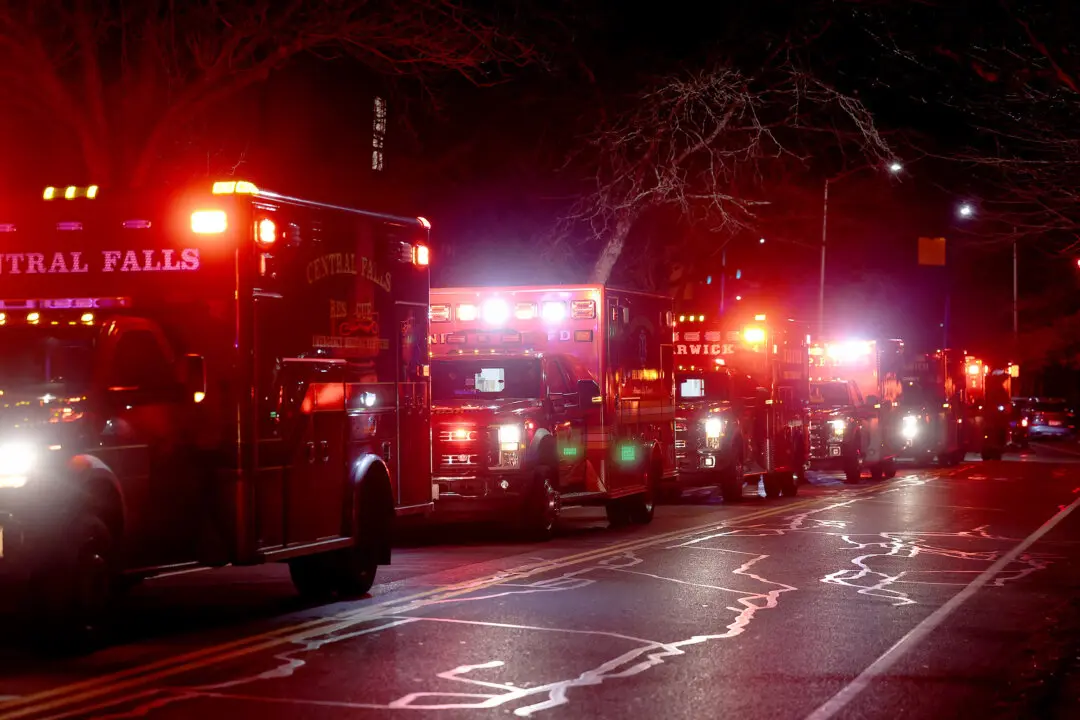EZ Acres farm owner Michael McMahon has been comfortably operating his 1800-acre dairy farm in Homer, N.Y., for several years, dutifully following the strict regulations imposed upon farmers since the late 1990s by the Federal Clean Water Act (CWA) to prevent contamination of groundwater and nearby navigable bodies of water.
McMahon complies with Concentrated Animal Feeding Operation or CAFO regulations, under which the U.S. Environmental Protection Agency (EPA) strictly regulates farmers who own 200 or more cows, inspecting for infractions such as man-made conveyances, uncontrolled wastewater, and feed storage discharge.
He pays $8,000 annually to a nutrient management specialist to devise a plan that avoids run-off and prevents McMahon from contaminating the groundwater when he applies manure as fertilizer to his grass and alfalfa crops.
This ensures he passes the annual CWA inspection conducted by the state of New York’s Department of Environmental Conservation (NYDEC).
So it came as quite a surprise to McMahon when he learned that the EPA and the U.S. Army Corps. of Engineers (ACE) had proposed changes to the Clean Water Act rules that could potentially extend the EPA’s reach further onto McMahon’s property to regulate miscellaneous accumulations of water like puddles, ditches, and “ephemeral” streams that may only appear once a year.
“Farmers are already under strict government regulations,” he said in a telephone interview.
The EPA proposed changes to the CWA that it said will clarify which streams and waterways are subject to permitting before farmers can institute certain practices on their land.
The EPA declined an interview, but referred the Epoch Times to a Question and Answer document.
Chesapeake Bay
The changes are intended to address two U.S. Supreme Court cases that “changed the test for determining which waters upstream of navigable waters should be protected under the Act,” states the EPA in the document.
McMahon doesn’t think he needs any more regulating.
“New York is doing an exemplary job at nutrient control,” he said.
He prides himself on being an active volunteer of New York’s Agricultural Environmental Management program, which “helps farmers make common-sense, cost-effective, and science-based decisions to help meet business objectives while protecting and conserving the State’s natural resources,” states the New York State Soil & Water Conservation Committee website.
According to McMahon, the state of New York maintains levels lower than the EPA hopes to achieve in the Chesapeake Bay, and the EPA has known about this program since the late ‘80s.
In mid June, Nancy Stoner, the EPA’s assistant chief administrator, and a representative from the New York office of the EPA, visited Chesapeake Bay watershed area farms in an effort to allay fears and concerns farmers had over the federal government’s expanded jurisdiction, and gather information before the comment period expired in July.
Twenty-five percent of McMahon’s land drains into Skaneateles Lake, one of the Finger Lakes. The other 75 percent of his land drains south and ultimately ends up in the Susquehanna River, the largest river feeding into the Chesapeake Bay.
The other farmers also had land that ultimately drained into the Chesapeake Bay.
The EPA explained its intention was to clarify the new test set forth by the court, said McMahon.
Apparently, the court’s decisions narrowed the scope of the CWA and “placed some waters in a gray area, where case-specific determinations were required,” according to one of the written answers.
Farmers Worry
“The EPA said they were just going to define the CWA and not expand, but in their attempts to clarify, it seemed to be an expansion to farmers,” said McMahon.
The farmers had questions and they were not satisfied with the lack of answers or the answers they received.
“Makes no sense at all, the more they explained, the more confusing it got,” said McMahon with exasperation.
He was concerned that seasonal waterways, those that only run during snow melt-off or during extreme rainfall called “ephemeral streams,” would be governed by the EPA. This would mean the farmers have to get permits or they would not be able to farm on some of their land on either side of the temporary stream.
The EPA stated in the Question and Answer document, “CWA permitting only applies where someone proposes to dump waste or other pollutants into the nation’s streams, rivers, lakes, and wetlands.”
During the meeting with New York farmers, the EPA was only concerned about seasonal waters reaching larger bodies of water, which farmers had seen happen twice that year.
Since there was no drainage occurring at the time of the meeting, the EPA did not see any need for regulation, according to McMahon. However, the question of whether the EPA would regulate if a sudden rainfall caused drainage to a larger body of water was left unanswered.
Farmers were confused by the ambiguities.
McMahon reiterated that he already hired a specialist to test everything, so he is operating from “real numbers and solid solutions.”
“The EPA used gray area words like proximity and nearby,” he said.
As a result of the continued confusion, the EPA extended the comments period until Oct. 20.
Farm Bureaus
The New York and Pennsylvania farm bureaus challenged the EPA’s proposed rule changes and sought assistance from Congress to ban the rule. They noted that the Clean Water Act is under the purview of Congress, therefore the EPA is acting beyond its scope by changing the rule.
Steve Ammerman, public affairs manager at the New York Farm Bureau, and Mark O'Neill, director of media and strategic communications at the Pennsylvania Farm Bureau, told the Epoch Times why the rule should be banned.
“Farms work with local regulators, the DEC, Soil and Water Conservation, so this will add another level of bureaucracy if we now have to get federal permits,” said Ammerman.
O'Neill similarly said Pennsylvania farmers are concerned about additional permits. “Farmers don’t know how the proposed rule will affect them because it is left to interpretation …” he said, [The farmers] are concerned that they have to get a permit for everything.”
While neither representative would say that the farmers think the EPA is just out for monetary gain, they each agreed that such changes could impact farmers economically.
“Applying fertilizer without a permit could subject farmers to fines, something they have done for years,” Ammerman noted.
O'Neill criticized the overall impact of the permits. “I don’t think they’re doing this to try to get farmers to shell out more money … but that is the effect.”
Ammerman and O'Neill agree that there is no guarantee the rule changes will result in waters being cleaner, better, or safer, but it could close off additional areas to farming.
“We all want the same thing, we all want clean water,” said O'Neill.
Ammerman pointed out that the rule change would not only affect agriculture, but also counties, homebuilders, and taxpayers. Even city water programs will potentially be affected.
The New York City EPA declined to comment, but the New York City Law Department is currently preparing comments for submission to the EPA on behalf of the city of New York.
New York’s state attorney general had no problem making his position clear.
On Sept. 16, Attorney General Eric Schneiderman led a coalition of eight states in submitting comments that support the EPA’s proposal. He said in a press release, “Every New Yorker has an equal right to clean water, which is fundamental to the health, environment, and economy of our states.”
The attorney general cited consistency and effectiveness in water pollution control among states as one of the reasons to support the proposal.
Joining Schneiderman in co-signing a letter were the attorneys general from Connecticut, Delaware, Illinois, Maryland, Rhode Island, Washington state, and the District of Columbia.
Congress supported the farmers’ position on expanded jurisdiction.
Acting on complaints from farm bureaus and other concerned individuals and organizations nationwide, the House of Representatives approved a bill on Sept. 9 to ban the proposed changes.
As for McMahon, he is hoping the EPA and the ACE will “come to their senses.” He believes these agencies were prompted to take action because President Barack Obama declared the Chesapeake Bay a national treasure that should be cleaned.
The state of New York already has an excellent program in place that keeps the bay clean, so the EPA is just going to extremes, said McMahon.
History of the Clean Water Act
Source: United States Environmental Protection Agency
The Federal Water Pollution Control Act, enacted in 1948, was the first major U.S. law enacted by Congress to address water pollution.
The act was reorganized and expanded in 1972 and renamed the Clean Water Act with the intent of setting wastewater standards for industry.
As a result of the reorganization, factories and sewage plants could be penalized for discharging pollutants into navigable waters without a permit. Navigable waters or Waters of the United States are protected under the act and currently include all waters used in interstate commerce, including wetlands. The Environmental Protection Agency (EPA) became the authority charged with implementing pollution control programs.
President Jimmy Carter signed the Clean Water Act of 1977 to reaffirm the government’s commitment to the protection of Americans and to give full funding to a construction grant program to encourage state and local planning.
Amendments in 1981 streamlined the municipal construction grants process, giving treatment plants more latitude under the program. The construction grant process was eliminated in 1987 and replaced with the Clean Water State Revolving Fund for sewage treatment, which addressed water quality needs by strengthening EPA-state partnerships.
In February 1998, President Bill Clinton announced a Clean Water Action Plan to restore and protect America’s waters. The initiative called for an additional $568 million to reduce “nonpoint” pollution—runoff from farms, city streets, and other sources.
In 2012, the Clean Water Act celebrated its 40th anniversary, but according to the EPA, although there has been great progress in reducing pollution, many challenges remain.





